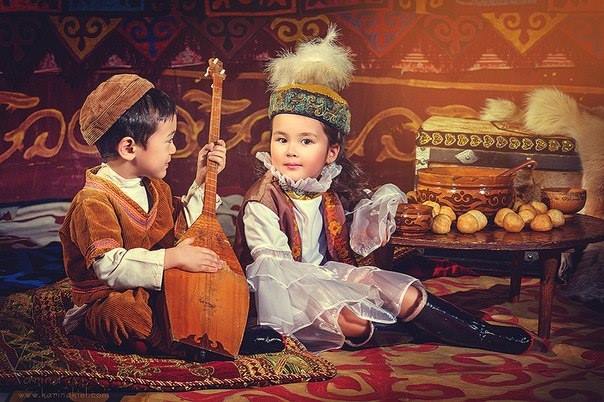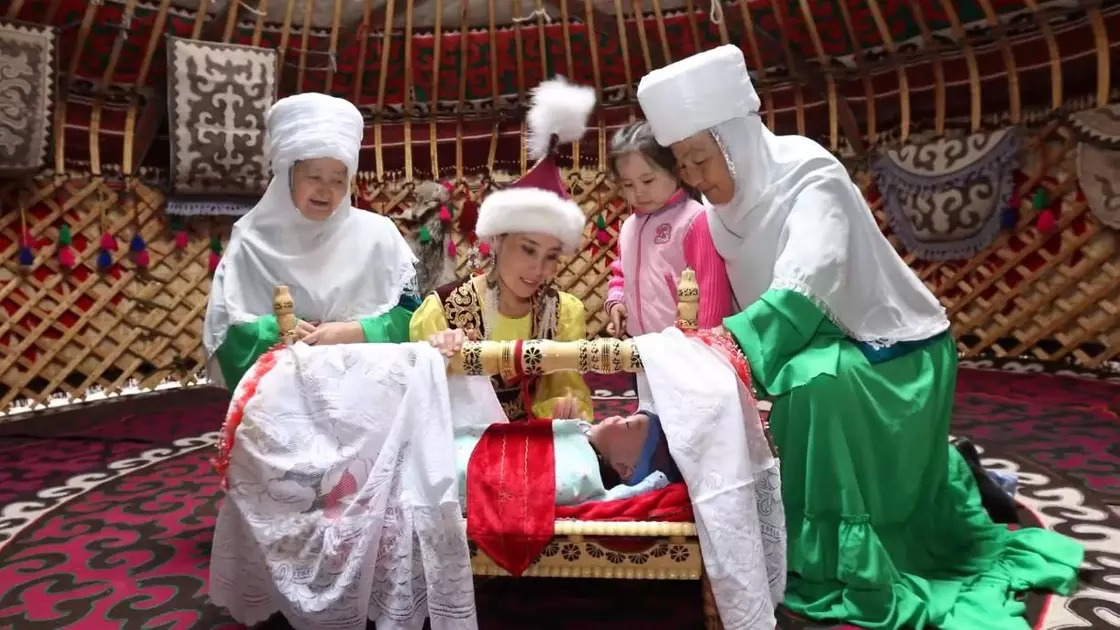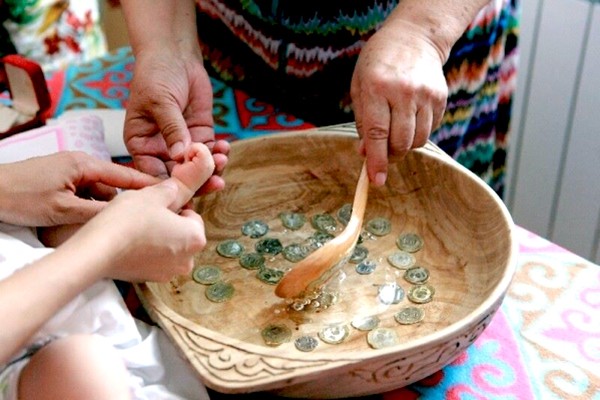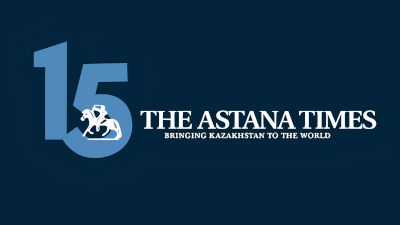ASTANA – The Kazakh people possess a rich and diverse cultural heritage, deeply rooted in traditions that emphasize family and kinship. Central to this heritage are customs designed to care for and protect children, ensuring their well-being and attracting good fortune. These traditions are reflected in rituals observed from a child’s birth through early childhood.

Photo credit: ummet.kz
Celebrating the birth of a child
Shildehana is a joyous celebration marking the birth of a child, typically held within the first week of life on an odd-numbered day—such as the third, fifth, or seventh. The term “shildehana” originates from the special 40-day period beginning at birth, during which the newborn is considered particularly vulnerable.
Upon learning of the baby’s arrival, relatives and friends would hurry to share the news by calling out “suyunshi,” meaning they brought joyful tidings. The bearer of the news was rewarded with a gift. The family gathered their loved ones for a celebratory feast, during which guests extended blessings for the child’s health and longevity.
In modern times, Shildehana often coincides with the discharge of the mother and baby from the hospital. While the celebration has become more modest, the tradition remains an important cultural milestone.
The first 40 days of a child’s life are considered sacred. During this time, a light was traditionally burning near the cradle to ward off dark forces. An essential figure in these rituals was the baby’s godmother, or kyndyk sheshe, who believed in passing her virtues and strength to the child and performing significant rites.

Besik salu ritual. Photo credit: YouTube channel Kausar Meirambai
One such ritual was Besik salu, placing the baby in the cradle. If the newborn was not the family’s first child, the cradle was inherited from the eldest sibling. The besik itself is a sacred item among Kazakhs, crafted from wood and adorned with ornaments. It features a small hole for a tube that connects to a potty, ensuring the baby’s comfort and hygiene. The cradle is secured with soft straps to prevent the baby from falling.
Symbolic items were placed in the cradle to reflect the child’s future aspirations. For a boy, a shapan (traditional coat) and a whip signified power and prosperity, while for a girl, a comb and mirror symbolized beauty and grace.
During the Shildehana or cradle celebration, the baby’s name was ceremonially given in the At koyu or Azan shakyru rite. Elders from the family and community gathered, and the senior-most relative pronounced the chosen name. This was followed by the mullah reciting a prayer and whispering the name three times into the baby’s ear, formally bestowing it upon the child.
Marking the first 40 days
Once a child has completed the first 40 days of life, another cherished Kazakh tradition, Kyrkynan shygaru, is observed. This milestone is celebrated to introduce the baby to the wider community, though the ceremony is traditionally attended only by female relatives and close, respected friends.

During Kyrkynan shygaru ceremony, the baby is bathed using the water from the bowl with silver items, ensuring that every part of the child’s body is rinsed. Photo credit: pandaland.kz
The ritual begins with the placement of 40 silver coins or other silver objects into a large bowl, symbolizing a prosperous and abundant life for the child. Each participant then pours a tablespoon of warm boiled water into the bowl, accompanied by heartfelt blessings and wishes for the baby’s future.
During the ceremony, the baby is bathed using the water from the bowl, ensuring that every part of the child’s body is rinsed. The baby’s nails and hair are also trimmed for the first time as part of the ritual. Afterward, the coins, bowl, and spoon are distributed among the guests as keepsakes, symbolizing the hope that the joy of the occasion will bring happiness to their households.
Tusaukeser: taking the first steps
Another meaningful Kazakh tradition, Tusaukeser, celebrates a child’s transition to walking independently. This symbolic ritual, known as the tradition to celebrate a child’s first attempts to walk, is rooted in the belief that failure to perform it could lead to the child facing obstacles in life, both literally and metaphorically.
Tusaukeser is typically performed when the child is about 12 months old and begins walking unassisted. To mark this moment, the family hosts a feast, inviting relatives and friends to join the celebration. The ceremony itself takes place after the meal.

The child’s feet are gently tied with a black-and-white string, representing the ability to discern between good and evil. Photo credit: abai.kz
The child’s feet are typically gently tied with a black-and-white string, representing the ability to discern between good and evil. The child is then placed on a special mat. A respected individual, often someone known for their vitality and large family, cuts the string. This act is believed to transfer their admirable qualities to the child. Two adults then hold the child’s hands and guide them across the mat, symbolizing a smooth and successful journey through life.

Shashu ritual involves showering the guests with sweets and coins, signifying abundance and good fortune. Photo credit: radiomarsho.com
As the child takes their first steps, the ritual concludes with the scattering of treats or Shashu. This custom involves showering the guests with sweets and coins, signifying abundance and good fortune. Children eagerly collect the scattered goodies, as it is believed that doing so will bring prosperity and happiness to their families. Even today, Shashu remains an integral part of Kazakh family celebrations, ensuring that all attendees share in the joy of the occasion.
Tilashar: unlocking a child’s speech
Tilashar is a vibrant and ancient Kazakh tradition designed to encourage a silent child to start speaking. It is believed that this ceremony “loosens the tongue” of a child who struggles to utter their first words. While the origins of this custom remain unclear, its execution and interpretation vary among families.
In one version, parents began preparing their children for speech at six months old by softly singing songs and reciting poems into their ears to help them learn words. If the child remained silent past the expected age, the Tilashar ceremony was held.
The family organized a celebration, Tilashar toi, where elders were invited to offer their blessings. A feast was prepared, and a ram was traditionally slaughtered to mark the occasion. The ritual included symbolic gestures, such as tying sheep intestines around the child’s neck, followed by an elder delivering words of wisdom and good wishes. These blessings, or bata, were intended to ensure that the child would master their native language and grow to be wise and just like their ancestors.
This tradition was not only seen as a way to encourage speech but also as a remedy for stuttering.
Over time, the Tilashar has evolved and is considered a precursor to another important milestone celebration, the Alippe toi, held to mark a child’s entry into the first grade.
In modern times, these events are often celebrated in cafes or restaurants, where family and friends gather. The guest of honor, the child, is ceremoniously presented on a decorated throne, symbolizing their transition to a new stage in life. Senior guests offer blessings, and the celebration unfolds in a lively, contemporary style.
Life cycles of wisdom
Kazakhs traditionally measured human age through life cycles known as mushel zhas, each spanning 12 years. The beginning of a new cycle was seen as a transitional year, marking significant milestones in a person’s life. These key years included ages 13, 25, 37, 49, 61, and so on.
The first mushel, ending at age 13, represented childhood. By this age, Kazakh youths were expected to master practical skills such as handling weapons, participating in baige (horse racing), and assisting with cattle farming, eventually becoming herders.
According to nomadic beliefs, these transitional years were considered a vulnerable period when individuals might face illnesses or life-threatening challenges. To protect themselves, those entering a new mushel zhas observed a symbolic ritual of generosity. They chose cherished possessions—typically clothing or other meaningful items—and distributed them to loved ones or those in need. The value of the items was not monetary but sentimental, reflecting the giver’s connection to them.
Another tradition associated with mushel zhas was a celebratory feast held at the cycle’s conclusion. Families would prepare a grand meal, often marked by the slaughter of a ram. The meat was shared entirely with guests, with none reserved for the hosts. This gesture symbolized a fresh start for the individual as they entered the next stage of life.


